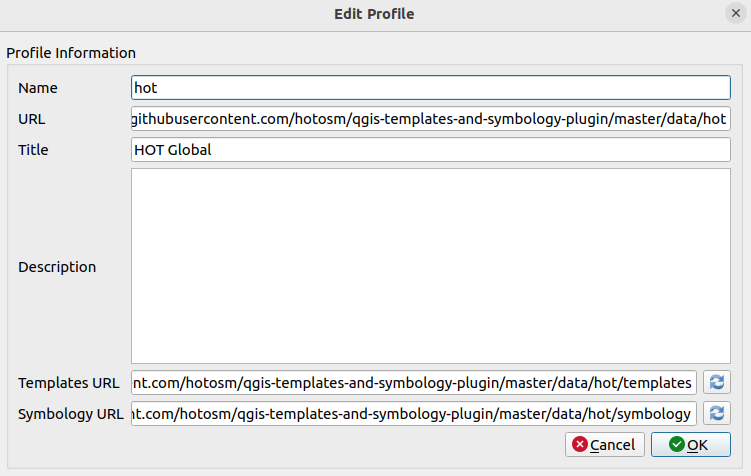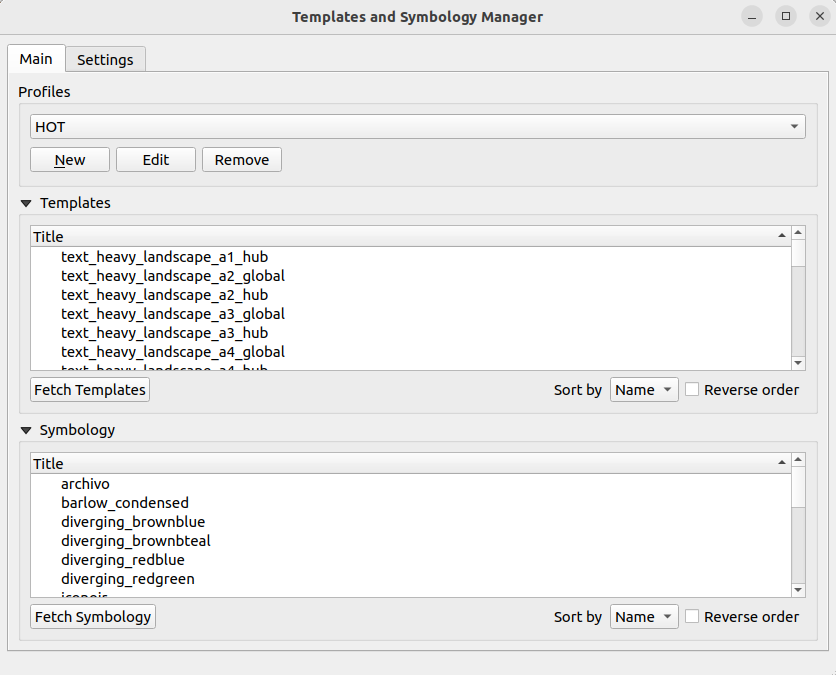QGIS plugin for managing map templates and symbology from HOTOSM.
During the development phase the plugin is available to install via a dedicated plugin repository https://raw.githubusercontent.com/hotosm/qgis-templates-and-symbology-plugin/release/docs/repository/plugins.xml
-
Open QGIS application and open plugin manager.
-
Search for
HOT Templates and Symbology Managerin the All page of the plugin manager. -
From the found results, click on the
HOT Templates and Symbology Managerresult item and a page with plugin information will show up. -
Click the
Install Pluginbutton at the bottom of the dialog to install the plugin.
Alternatively the plugin can be installed using Install from ZIP option on the QGIS plugin manager.
-
Download zip file from the required plugin released version https://github.com/hotosm/qgis-templates-and-symbology-plugin/releases/download/{tagname}/qgis_templates_symbology.{version}.zip
-
From the Install from ZIP page, select the zip file and click the Install button to install plugin
-
Open the QGIS plugin manager, then select the Settings page
-
Click Add button on the Plugin Repositories group box and use the above url to create the new plugin repository.
-
The plugin should now be available from the list of all plugins that can be installed.
Disable QGIS official plugin repository in order to not fetch plugins from it.
NOTE: While the development phase is on going the plugin will be flagged as experimental, make sure to enable the QGIS plugin manager in the Settings page to show the experimental plugins in order to be able to install it.
When the development work is complete the plugin will be available on the QGIS official plugin repository.
The plugin can be used with the default profile that is available after install, users can also add new profiles that contain different templates and symbology files.
The plugin default profile has templates and symbology designed for HOT related users, the plugin enables
- Download of profile templates and their corresponding projects.
- Loading of the layouts into the QGIS layout designer.
- Download of profile symbology into the filesystem.
- Fetching for the profile new resources.
The plugin profile dialog allow creation of a new profile using a pre-defined format designed specifically to
be used with this plugin.
The profile resources needs to be hosted as HTTP resources accessed via
profile_host/data/{profile_name} eg. https://github.com/hotosm/qgis-templates-and-symbology-plugin/master/data/hot
Template resources should be under profile_host/data/{profile_name}/templates with a data.json file
inside profile_host/data/{profile_name}/templates/data endpoint, this json file should contain a list of all templates
for the profile. Example data.json file can be found here https://github.com/hotosm/qgis-templates-and-symbology-plugin/master/data/hot/templates/data/data.json
Same to the symbology resources they should be under profile_host/data/{profile_name}/symbology with a data.json file
inside profile_host/data/{profile_name}/symbology/data endpoint, and a json file should contain a list of all symbology and their properties
for the profile. Example data.json file can be found here https://github.com/hotosm/qgis-templates-and-symbology-plugin/master/data/hot/symbology/data/data.json
When creating a new profile the following details are needed.
- Name of the profile, used to identify the profile.
- URL of the profile, HTTP URL that will point to the profile resources.
- Title of the profile.
- Description about the profile resources.
- Templates URL, url used to locate the profile templates resources.
- Symbology URL, url used to locate the profile symbology.
Example profile dialog with details

To use the plugin for development purposes, clone the repository locally, install pip, a python dependencies management tool see https://pypi.org/project/pip/
Using any python virtual environment manager create project environment. Recommending to use virtualenv-wrapper.
It can be installed using python pip
pip install virtualenvwrapper
-
Create virtual environment
mkvirtualenv templates_symbology -
Using the pip, install plugin development dependencies by running
pip install -r requirements-dev.txt
To install the plugin into the QGIS application, activate virtual environment and then use the below command
python admin.py install


